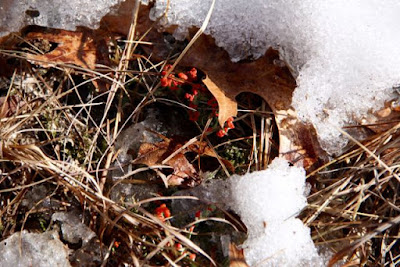 |
| last year's late Winter woods
Photo by J. Harrington
|
The walk I took last February 27 led me to discover British soldier lichen growing in the field between the house and the wet woods to the West. That led me to want to know more about lichens. According to the Minnesota Seasons web site, British soldier lichens can be found throughout our North Woods. I had previously picked up a Lichens of the North Woods field guide by Joe Walewski, because I wanted to identify some orange lichens growing on the rocks at Lake Superior's shore line. Walewski's reference didn't specifically include British soldier lichens so I finally took my photo to the good folks staffing Wild River State Park and they got me pointed in the right direction to identify my "discovery." The St. Croix River Valley and Anoka Sandplain Guide to Native Habitats mentions British soldier lichens as being native to but unusual in Barrens Prairie habitats whereas Minnesota Seasons notes their status as "widespread and common" (your mileage may vary). Presumably because lichen are neither plant nor animal(?), the USA-NPN Botany Primer doesn't mention lichen at all. A few other interesting facts, including their use as a fabric dye, can be found here.
 |
| British soldier lichen surrounded by snow
Photo by J. Harrington
|
True confession time: I haven't yet hiked out to see if the skunk cabbage is up yet. I'll try to get to that this week. That's what I was checking for a year ago when I literally stumbled over the British soldier lichens. I suppose my origins in Boston and Plymouth give me a stronger affinity for uncovering British soldiers of one kind or another than searching for smelly plants. That's my story and I'm sticking to it (for today).
Springtime in the Rockies, Lichen
All these years I overlooked them in theracket of the rest, thissymbiotic splash of plant and fungus feedingon rock, on sun, a little moisture, air —tiny acid-factories dissolvingsalt from living rocks andeating them.
Here they are, blooming!Trail rock, talus and scree, all dusted with it:rust, ivory, brilliant yellow-green, andcliffs like murals!Huge panels streaked and patched, quietlywith shooting-stars and lupine at the base.
Closer, with the glass, a city of cups!Clumps of mushrooms and where do theplants begin? Why are they doing this?In this big sky and all around me peaks &the melting glaciers, why am I made tokneel and peer at Tiny?
These are the stamps of the final envelope.
How can the poisons reach them?In such thin air, how can they care for theloss of a million breaths?What, possibly, could make their ground more bare?
Let it all die.
The hushed globe will wait and wait forwhat is now so small and slow toopen it again.
As now, indeed, it opens it again, thisscentless velvet,crumbler-of-the-rocks,
this Lichen!
********************************************
Thanks for visiting. Come again when you can.
Please be kind to each other while you can.
No comments:
Post a Comment